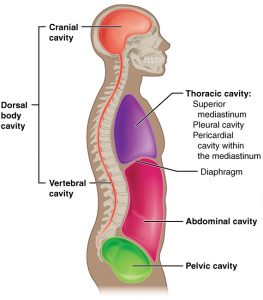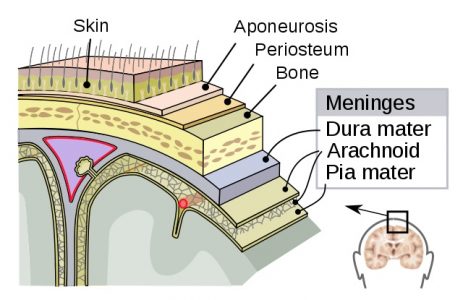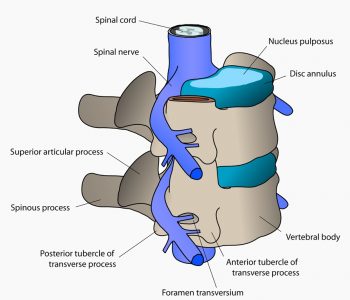Dorsal Cavity Definition
The dorsal cavity, or dorsal body cavity, is a fluid filled space which surrounds the brain and spinal cord of vertebrates. The dorsal cavity is usually considered as two semi-separate spaces, the cranial cavity and the spinal cavity, housing the brain and spinal cord, respectively. However, the fluid in the dorsal cavity connects between the brain and spinal cord, but is separated completely from the blood. The separation of the brain via the dorsal cavity and specialized epithelial cells is known as the blood-brain barrier.
Function of the Dorsal Cavity
Like most body cavities, the dorsal cavity protects what’s inside by providing a cushion from damage and impacts with the environment and other organisms. The space around the brain and spinal column is filled with fluid, which acts as a buffer around the structures. As forces push against the dorsal cavity, the fluid inside is pressurized and pushed back. This severely reduces the force against the brain and spinal cord. Both of these structures are made of highly sensitive nervous tissue, which is easily damaged.
The fluid surrounding the brain and spinal cord is called cerebrospinal fluid. Cerebrospinal fluid is a clear fluid produced by special cells within the brain. The fluid is very similar to blood plasma, except that the fluid has almost no proteins and no red blood cells. The cavity and the cerebrospinal fluid function together not only to protect the brain, but they allow the removal of wastes and regulation of intracranial pressure. These functions allow the brain cells to work efficiently and allow regulation of blood pressure in the brain.
Interestingly, the dorsal cavity and cerebrospinal fluid actually decrease the weight of the brain by making it buoyant. While a brain by itself is around 1500 grams, when suspended in cerebrospinal fluid it is equivalent to only around 50 grams. This massive decrease in functional weight allows the brain to be much larger without collapsing under its own weight.
Human Dorsal Cavity Parts & Organs
As seen in the image below, the dorsal cavity consists of two parts: the cranial cavity and the vertebral (spinal) cavity. The dorsal cavity starts with a membrane and the inside of the skull, traveling down through the spinal column as a protection for the spinal cord.
Cranial Cavity
Within the cranial cavity, there are a series of membranes which help contain the dorsal cavity and surround the brain. These membranes are called meninges, and can be seen in the image below.
The thick dura mater sits just below the bone of the skull, and attaches there. The arachnoid membrane attaches just below. Between the arachnoid and the final pia mater, there exists the cranial cavity. The cranial cavity is filled with cerebrospinal fluid and reinforced by a variety of cross membrane support proteins.
Spinal Cavity
The spinal cavity, the lower portion of the dorsal cavity, consists of a series of holes running down the length of the vertebral column. The meninges of the brain extend down the dorsal cavity to protect the spinal cord, as seen in the image below.
The main purpose of the spinal cavity is similar to that of the cranial cavity. The spinal cord is extremely sensitize to damage and must be cushioned. Further, the separation provides some protection from exposure to bacteria and viruses. When these invaders do attack the brain and spinal tissues, the dorsal cavity provides an open space through which immune cells can respond to the attack.
Collecting Cerebrospinal Fluid through the Dorsal Cavity
A common medical procedure, the lumbar puncture, is used for collecting cerebrospinal fluids. Doctors may want to check these fluids for a number of reasons, many of which tell them about the condition of the dorsal cavity. For instance, they may need to collect some fluid to test for the presence of bacterial proteins. This could indicate an infection in the meninges, called meningitis. Doctors may also want to check the pressure and general condition of the dorsal cavity to make sure it is functioning properly.
A dorsal cavity which is clogged or otherwise abnormal can lead to increased intracranial pressure, decreasing brain functioning. A leaking dorsal cavity can also lead to decreased brain function, headaches and other associated symptoms. This is due to the fact that the brain must operate within a very narrow boundary of cerebrospinal pressure, ensuring the brain remains buoyant within the dorsal cavity without being over pressurized.
Testing the fluid received from the dorsal cavity allows doctors to see the components of the fluid, and which substances should and shouldn’t be present. This sometimes allows for a diagnosis of diseases like infection, cancer, and autoimmune disease in patients.
Quiz
References
- Feldhamer, G. A., Drickamer, L. C., Vessey, S. H., Merritt, J. F., & Krajewski, C. (2007). Mammology: Adaptation, Diversity, Ecology (3rd ed.). Baltimore: The Johns Hopkins University Press.
- Pough, F. H., Janis, C. M., & Heiser, J. B. (2009). Vertebrate Life. Boston: Pearson Benjamin Cummings.
- Widmaier, E. P., Raff, H., & Strang, K. T. (2008). Vander’s Human Physiology: The Mechanisms of Body Function (11th ed.). Boston: McGraw-Hill Higher Education.



